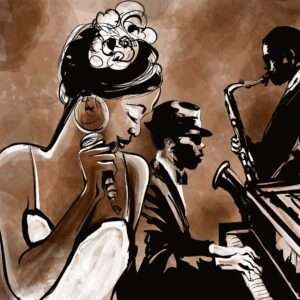“Music expresses that which cannot be said and on which it is impossible to be silent.” This quote by Victor Hugo is great unless you are unable to hear the glorious sounds of music. Unfortunately, about 10 percent of the U.S. adult population, or about 25 million Americans, has experienced tinnitus (ringing in the years) lasting at least five minutes in the past year1 . Here are a couple of stats on hearing loss that you may not be aware of:
- Men are almost twice as likely as women to have hearing loss among adults aged 20-69.
- Non-Hispanic white adults are more likely than adults in other racial/ethnic groups to have hearing loss; non-Hispanic black adults have the lowest prevalence of hearing loss among adults aged 20-69.
Jay Harold has finally found a health care problem in which Black or Hispanic Americans aren’t worse off than White Americans. I guess White Males listening to hard rock music in the 1980’s may have contributed to their hearing loss.
The facts remain that hearing loss is a significant problem for everyone. The World Health Organization provided the following stats about noise-induced hearing loss2 .
- According to the World Health Organization, nearly 50% of persons aged 12-35 years could be exposed to unsafe levels of sound from the use of personal audio devices. Around 40% of individuals in that age range could be exposed to potentially damaging levels of sound at entertainment venues.
- During 2001–2008, an estimated 30 million Americans older than 12 years had hearing loss in both ears. An estimated 48 million had hearing loss in at least one ear.
- The National Health Interview Survey (NHIS) found that in 2014, an estimated 21.0% of adults aged ≥18 years had difficulty following a conversation amid background noise, 11.2% had ringing in the ears (tinnitus), and 5.9% had a sensitivity to everyday sounds.

- A National Health and Nutrition Examination Survey (NHANES)-based study from 2005–2008 estimated that 2.5 million youths aged 12–19 years have ringing in the ears (tinnitus).
- About 10 percent of the U.S. adult population, or about 25 million Americans, has experienced tinnitus lasting at least five minutes in the past year.
Five More Stats to Know
- The cumulative effects of hearing damage are more noticeable among older adults. As described in a report from the President’s Council of Advisors on Science and Technology, nearly half of people older than 60 years have hearing loss. As more people live longer, these numbers are expected to grow, from 46 million in 2014 to 82 million in 2040.
- Hearing loss is the third most common chronic physical condition in the United States and is twice as prevalent as diabetes or cancer.
- The economic cost to society of age-related hearing loss is estimated to be $297,000 over the lifetime of every affected person.
- Those who have hearing loss are more likely to have low employment rates, lower worker productivity, and high healthcare costs. Hearing-impaired adults are more likely to have low income and be unemployed or underemployed than adults with normal hearing.
- Nationally, the total cost of first-year hearing loss treatment is projected to multiply five-fold between 2002 and 2030, from $8.2 billion to $51.4 billion.
What Causes Hearing Loss?
Many factors can contribute to hearing loss as you get older. It can be difficult to distinguish age-related hearing loss from hearing loss that can occur for other reasons, such as long-term exposure to noise.
Noise-induced hearing loss3 is caused by long-term exposure to sounds that are either too loud or last too long. This kind of noise exposure can damage the sensory hair cells in your ear that allows you to hear. Once these hair cells are damaged, they do not grow back, and your ability to hear is diminished.
Conditions that are more common in older people, such as high blood pressure or diabetes, can contribute to hearing loss. Medi cations that are toxic to the sensory cells in your ears (for example, some chemotherapy drugs) can also cause hearing loss.
cations that are toxic to the sensory cells in your ears (for example, some chemotherapy drugs) can also cause hearing loss.
Rarely, an age-related hearing loss can be caused by abnormalities of the outer ear or middle ear. Such abnormalities may include reduced function of the tympanic membrane (the eardrum) or reduced function of the three tiny bones in the middle ear that carry sound waves from the tympanic membrane to the inner ear.
Most older people who experience hearing loss have a combination of both age-related hearing loss and noise-induced hearing loss.
Can I prevent age-related hearing loss?
At this time, scientists don’t know how to avoid age-related hearing loss. However, you can protect yourself from noise-induced hearing loss by protecting your ears from sounds that are too loud and last too long. It’s important to be aware of potential sources of damaging noises, such as loud music, firearms, snowmobiles, lawn mowers, and leaf blowers. Avoiding loud noises, reducing the amount of time you’re exposed to loud noise, and protecting your ears with ear plugs or ear muffs are easy things you can do to protect your hearing and limit the amount of hearing you might lose as you get older.
Additional Resources on Hearing Loss
Hearing Loss Association of America
National Institute on Deafness and Other Communication Disorders
World Health Organization – Deafness and hearing Loss
Enjoyed this post? Share it and read more here. Jay Harold has put together a Resource page that you may find useful when trying to improve your health and wealth. Please take this advice of Muhammad Ali and give back to others. “Service to others is the rent you pay for your room here on earth.” ~ Muhammad Ali.




